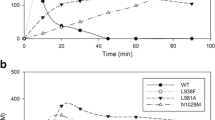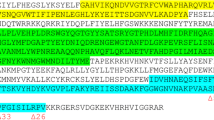Abstract
Dextran glucosidase from Streptococcus mutans (SMDG), an exo-type glucosidase of glycoside hydrolase (GH) family 13, specifically hydrolyzes an α-1,6-glucosidic linkage at the non-reducing ends of isomaltooligosaccharides and dextran. SMDG shows the highest sequence similarity to oligo-1,6-glucosidases (O16Gs) among GH family 13 enzymes, but these enzymes are obviously different in terms of substrate chain length specificity. SMDG efficiently hydrolyzes both short-and long-chain substrates, while O16G acts on only short-chain substrates. We focused on this difference in substrate specificity between SMDG and O16G, and elucidated the structure-function relationship of substrate chain length specificity in SMDG. Crystal structure analysis revealed that SMDG consists of three domains, A, B, and C, which are commonly found in other GH family 13 enzymes. The structural comparison between SMDG and O16G from Bacillus cereus indicated that Trp238, spanning subsites +1 and +2, and short β → α loop 4, are characteristic of SMDG, and these structural elements are predicted to be important for high activity toward long-chain substrates. The substrate size preference of SMDG was kinetically analyzed using two mutants: (i) Trp238 was replaced by a smaller amino acid, alanine, asparagine or proline; and (ii) short β → α loop 4 was exchanged with the corresponding loop of O16G. Mutant enzymes showed lower preference for long-chain substrates than wild-type enzyme, indicating that these structural elements are essential for the high activity toward long-chain substrates, as implied by structural analysis.
Similar content being viewed by others
Abbreviations
- CGTase:
-
cyclodextrin glucanotransferase
- DP:
-
degree of polymerization
- GH:
-
glycoside hydrolase
- O16G:
-
oligo-1,6-glucosidase
- SMDG:
-
Streptococcus mutans dextran glucosidase
- TVAII:
-
Thermoactinomyces vulgaris R-47 α-amylase II
References
Coutinho P.M. & Henrissat B. 1999. Carbohydrate-active enzymes: an integrated database approach, pp. 3–12. In: Gilbert H.J., Davies G., Henrissat B. & Svensson B. (eds), Recent Advances in Carbohydrate Bioengineering, The Royal Society of Chemistry, Cambridge.
Hondoh H., Kuriki T. & Matsuura Y. 2003. Three-dimensional structure and substrate binding of Bacillus stearothermophilus neopullulanase. J. Mol. Biol. 326: 177–188.
Hondoh H., Saburi W., Mori H., Okuyama M., Nakada T., Matsuura Y. & Kimura A. 2008. Substrate recognition mechanism of α-1,6-glucosidic linkage hydrolyzing enzyme, dextran glucosidase from Streptococcus mutans. J. Mol. Biol. 378: 911–920.
Inohara-Ochiai M., Nakayama T., Goto R., Nakao M., Ueda T. & Shibano Y. 1997. Altering substrate specificity of Bacillus sp. SAM1606 α-glucosidase by comparative site-directed mutagenesis. J. Biol. Chem. 272: 1601–1607.
Kadziola A., Sřgaard M., Svensson B. & Haser R. 1998. Molecular structure of a barley α-amylase-inhibitor complex: implications for starch binding and catalysis. J. Mol. Biol. 278: 205–217.
Linger L. & Sund M.L. 1981. Characterization of dextran glucosidase (1,6-α-d-glucan glucohydrolase) of Streptococcus mitis. Caries Res. 15: 436–444.
MacGregor E.A., Janecek S. & Svensson B. 2001. Relationship of sequence and structure to specificity in the α-amylase family of enzymes. Biochim. Biophys. Acta 1546: 1–20.
Noguchi A., Yano M., Ohshima Y., Hemmi H., Inohara-Ochiai M., Okada M., Min K.S., Nakayama T. & Nishino T. 2003. Deciphering the molecular basis of the broad substrate specificity of α-glucosidase from Bacillus sp. SAM1606. J. Biochem. 134: 543–550.
Ohya T., Sawai T., Uemura S. & Abe K. 1978. Some catalytic properties of an exo-1,6-α-glucosidae (glucodextranase) from Arthrobacter globiformis 142. Agric. Biol. Chem. 42: 571–577.
Stam M.R., Danchin E.G., Rancurel C., Coutinho P.M. & Henrissat B. 2006. Dividing the large glycoside hydrolase family 13 into subfamilies: towards improved functional annotations of α-amylase-related proteins. Protein Eng. Des. Sel. 19: 555–562.
Russell R.R., Aduse-Opoku J., Sutcliffe I.C., Tao L. & Ferretti J.J. 1992. A binding protein-dependent transport system in Streptococcus mutans responsible for multiple sugar metabolism. J. Biol. Chem. 267: 4631–4637.
Russell R.R. & Ferretti J.J. 1990. Nucleotide sequence of the dextran glucosidase (dexB) gene of Streptococcus mutans. J. Gen. Micorobiol. 136: 803–810.
Saburi W., Mori H., Saito S., Okuyama M. & Kimura A. 2006. Structural elements in dextran glucosidase responsible for high specificity to long chain substrate. Biochim. Biophys. Acta 1764: 688–698.
Skov L.K., Mirza O., Henriksen A., De Montalk G.P., Remaud-Simeon M., Sarcabal P. Willemot R. M., Monsan P. & Gajhede M. 2001. Amylosucrase, a glucan-synthesizing enzyme from the α-amylase family. J. Biol. Chem. 276: 25273–25278.
Sprogoe D., van den Broek L.A.M., Mirza O., Kastrup J.S., Voragen A.G.J., Gajhede M. & Skov L.K. 2004. Crystal structure of sucrose phosphorylase from Bifidobacterium adolescentis. Biochemistry 43: 1156–1162.
Suzuki Y., Aoki R. & Hayashi H. 1982. Assignment of a p-nitrophenyl-α-d-glucopyranoside-hydrolyzing-α-glucosidase of Bacillus cereus ATCC 7064 to an exo-oligo-1,6-glucosidase. Biochim. Biophys. Acta 704: 476–483.
Suzuki Y., Fujii H., Uemura H. & Suzuki M. 1987. Purification and characterization of extremely thermostable exo-oligo-1,6-glucosidase from a caldoactive Bacillus sp. KP 1228. Starch 39: 17–23.
Suzuki Y. & Tomura Y. 1986. Purification and characterization of Bacillus coagulans oligo-1,6-glucosidase. Eur. J. Biochem. 158: 77–83.
Suzuki Y., Yuki T., Kishigami T. & Abe S. 1976. Purification and properties of extracellular α-glucosidase of a thermophile, Bacillus thermoglucosidus KP 1006. Biochim. Biophys. Acta 445: 386–397.
Tao L., Sutcliffe I.C., Russell R.R. & Ferretti J.J. 1993. Cloning and expression of the multiple sugar metabolism (msm) operon of Streptococcus mutans in heterologous streptococcal hosts. Infect. Immun. 61: 1121–1125.
van der Veen B.A., Leemhuis H., Kralj S., Uitdehaag J.C.M., Dijkstra B.W. & Dijkhuizen L. 2001. Hydrophobic amino acid residues in the acceptor binding site are main determinants for reaction mechanism and specifity of cyclodextringlycosyltransferase. J. Biol. Chem. 276: 44557–44562.
Watanabe K., Hata Y., Kizaki H., Katsube Y. & Suzuki Y. 1997. The refined crystal structure of Bacillus cereus oligo-1,6-glucosidase at 2.0 Å resolution: structural characterization of proline-substitution sites for protein thermostabilization. J. Mol. Biol. 269: 142–153.
Yokota T., Tonozuka T., Shimura Y., Ichikawa K., Kamitori S. & Sakano Y. 2001. Structure of Thermoactinomyces vulgaris R-47 α-amylase II complexed with substrate analogue. Biosci. Biotechnol. Biochem. 65: 619–626.
Author information
Authors and Affiliations
Corresponding authors
Rights and permissions
About this article
Cite this article
Saburi, W., Hondoh, H., Kim, YM. et al. Structure-function relationship of substrate length specificity of dextran glucosidase from Streptococcus mutans . Biologia 63, 1000–1005 (2008). https://doi.org/10.2478/s11756-008-0165-1
Received:
Accepted:
Published:
Issue Date:
DOI: https://doi.org/10.2478/s11756-008-0165-1




